HTML
--> --> -->In addition, changes in the surface roughness due to urbanization would modify the airflow. A city can also divert the approaching air, which can then converge on the downwind side of the city to produce upward motion (Cotton and Pielke, 2007). Recently, Zhang et al. (2019) found that the building complexes in a city can form a mesoscale wake on the downwind side of the city. However, Cheng and Chan (2012) suggested that the increased roughness can actually lead to enhanced convergence over the city itself so that precipitation is increased there. Aerosols have also been shown to have a certain impact on urban precipitation. Khain et al. (2005) and Zhang et al. (2011) suggested that the presence of a large concentration of aerosols can decrease the precipitation efficiency of most single clouds, but can contribute towards the development of intense convection, and hence thunderstorms. In addition, the efficiency of both warm and cold-rain processes is reduced in polluted clouds, which explains how urban aerosols affect precipitation through cloud microphysical processes (Rosenfeld, 2000).
The climate and environmental problems of urbanization are different in different regions. Since the 1980s, the Pearl River Delta (PRD) region in China has witnessed rapid economic development and rapid expansion of urban land, which has led to a huge urban area. Luo et al. (2009) analyzed the climate change characteristics of Guangdong Province in China (within which lies the PRD) in the period 1959?2005 and found that precipitation showed a rising trend along the coastal cities (including those in the PRD). The PRD metropolitan region has experienced more heavy rain events but fewer weaker ones compared with the nearby non-urban regions, based on data from the Tropical Rainfall Measuring Mission satellite (Li et al., 2011). Extreme precipitation over the PRD was also found to be enhanced by urban extent (Wang et al., 2015). Chen et al. (2015) also showed that the urban areas in the PRD experienced fewer precipitation events and with shorter duration than in the surrounding rural areas using the satellite data from the Climate Prediction Center morphing technique. However, the impact of urban expansion on precipitation in the PRD is complicated to generalize (Lin et al., 2009). Wu et al. (2019) found the extreme hourly precipitation in the PRD increased with urbanization mainly due to the strong urban heat island effect. Based on the results of numerical experiments, Holst et al. (2016) showed that a large increase in anthropogenic heat flux in the urban area can produce a substantial increase in heavy precipitation there. Such an increase is related to the horizontal extent of urbanization (Holst et al., 2016, 2017). Urban effects on precipitation associated with tropical cyclones (TCs) have also been investigated. Based on model simulations, Chan et al. (2019) concluded that rainfall intensity associated with landfalling TCs along the South China coast was enhanced due to an increase in surface roughness over land.
In the past, most observational studies have compared precipitation characteristics between single sites, making it difficult to generalize the results. Analyses of satellite estimates of precipitation suffer from the problems of low resolution. Very few existing studies examine the precipitation characteristics in different seasons, or consider the influence of synoptic-scale weather systems such as monsoons and TCs. The objective of this study is therefore to perform, for the first time, a systematic analysis of the urban effect on these characteristics within a large domain and over a relatively long period of time. Hourly rain gauge data in Guangdong Province from 1981 to 2015 are used to provide more detailed (spatial and temporal) observations than ever before, so that short duration and localized rainfall events can be better identified. In addition to the annual variation, analyses for different periods are also carried out: warm season, non-warm season, pre-flood season, post-flood season, and TC periods (to be defined in section 2). The characteristics of precipitation investigated include precipitation amount, precipitation frequency, intense rainfall, and extreme precipitation frequency (see section 2 for definitions). The purpose of this study is to investigate how urbanization might have affected the variation of these precipitation characteristics in the urban areas of Guangdong Province.
Section 2 describes the data used and the methodology. The results are presented in section 3. A summary of these results and possible explanations are given in section 4.
Any hourly precipitation ≥ 0.1 mm was included in the precipitation sample to calculate the precipitation frequency. Intense rainfall was defined as hourly precipitation ≥ 20 mm, according to the definition of flash heavy rain by the CMA. It is inappropriate to define extreme precipitation with an absolute value for all observation stations. Instead, the 99.9th percentile was used as the threshold to define the extreme hourly rainfall. For each site, hourly precipitation samples of the total 35 years were sorted in descending order. Precipitation samples in the top 0.1% of all samples included were then defined as the extreme precipitation for that site.
From the perspective of urban population, land use, and satellite-based nighttime light data, Guangdong Province, especially the PRD region, has been experiencing accelerated urbanization since the mid-1990s. Guangdong Province was 17.4% urbanized in 1980, but this increased to 68.7% in 2015 (National Bureau of Statistics,
The trend of precipitation change was statistically analyzed using the non-parametric Mann?Kendall test (Mann, 1945; Kendall, 1975), which has been used in many investigations of temporal trends of climate time series, especially when station data are examined (Hirsch et al., 1991). A non-parametric test is necessary to reduce the problem associated with data skewness (Smith, 2000).
3.1. Variation of annual precipitation characteristics
The annual precipitation shows an increasing trend at some stations in the urban areas (Fig. 1a). However, the rainfall frequency (Fig. 1b) and light rainfall frequency (Fig. 1d) show decreasing trends in most areas of the entire province. On the other hand, intense rainfall is increasing, especially in the PRD (Fig. 1c).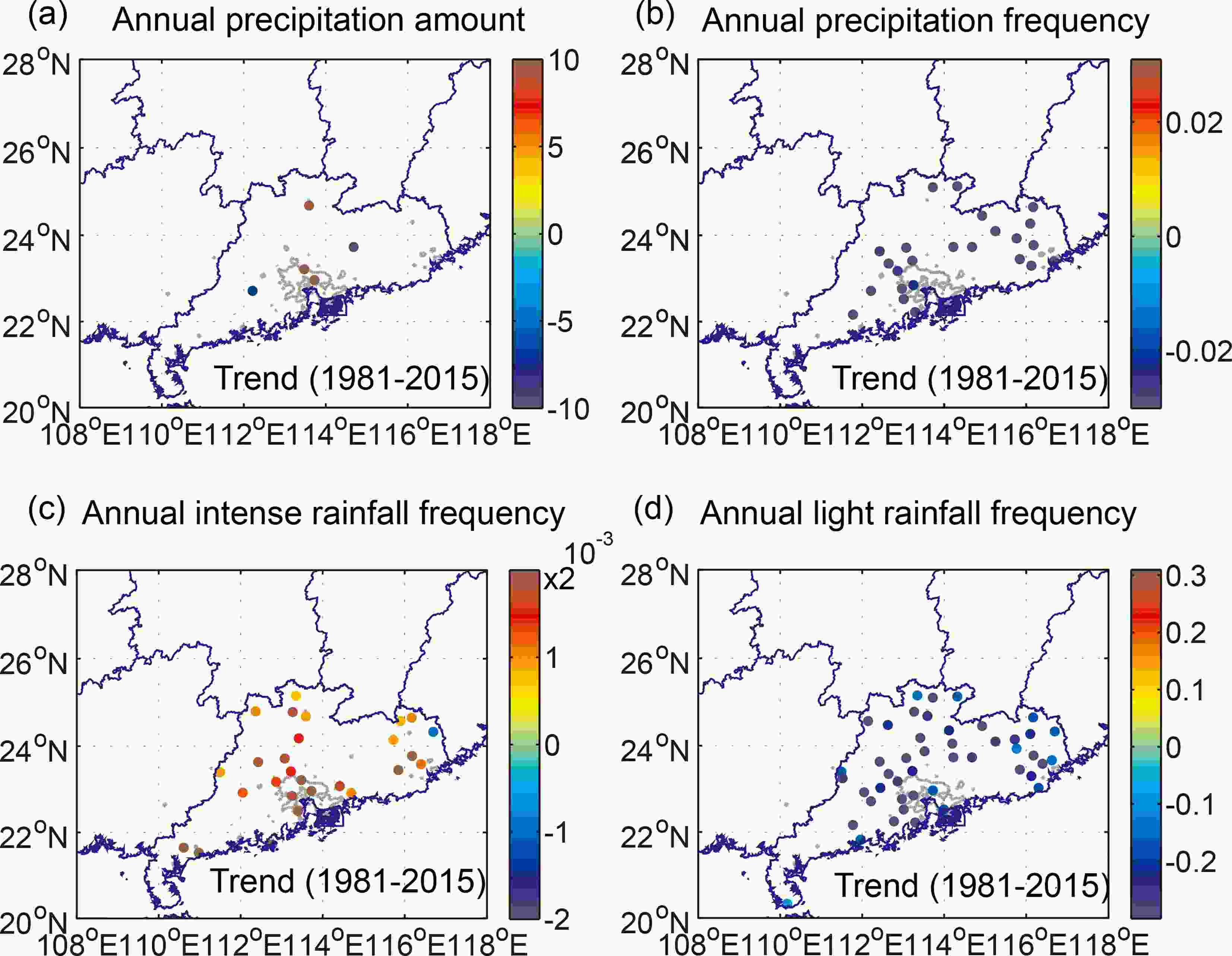 Figure1. The trend distribution of (a) annual precipitation (units: mm yr?1), (b) precipitation frequency (units: % yr?1), (c) intense rainfall frequency (units: % yr?1), and (d) light rainfall frequency (units: % yr?1) in Guangdong Province during 1981?2015. Gray lines represent urban areas. Warm tones represent a positive trend, while cool tones represent a negative trend. The magnitude of the value represents the extent of the increase or decrease. Only sites that pass the 90% Mann?Kendal trend test are shown.
Figure1. The trend distribution of (a) annual precipitation (units: mm yr?1), (b) precipitation frequency (units: % yr?1), (c) intense rainfall frequency (units: % yr?1), and (d) light rainfall frequency (units: % yr?1) in Guangdong Province during 1981?2015. Gray lines represent urban areas. Warm tones represent a positive trend, while cool tones represent a negative trend. The magnitude of the value represents the extent of the increase or decrease. Only sites that pass the 90% Mann?Kendal trend test are shown.Based on the nighttime light data, all 14 sites within the PRD region were chosen to represent the urban area. In addition, nine sites around the urban agglomeration were considered to be the rural area (see Fig. A1 in Appendix). For the urban areas, precipitation frequency has a decreasing trend, but precipitation amount as well as intense rainfall and extreme precipitation frequency all show an increasing trend (Fig. 2a). This trend is the largest for the intense rainfall and is statistically significant at the 95% level based on the Mann?Kendall test. These results also suggest that the increase of precipitation is mainly contributed by intense rainfall events. In other words, deep and strong convection is becoming more frequent in urban areas. Note also a substantial jump in both the precipitation amount and the intense rainfall frequency after the early 1990s when the PRD region became more urbanized. On the other hand, the precipitation amount and frequency of non-urban areas both have a decreasing trend (Fig. 2b). Although the heavy and extreme precipitation also show an increasing trend, they are not as strong and significant as that in urban areas. The intense rainfall shows a significant increasing trend in 8 of 14 urban sites and only 1 of 9 non-urban sites. This comparison between urban and rural sites illustrates the important impact of urbanization on the precipitation characteristics in Guangdong Province. In addition, the substantial increase in precipitation characteristic parameters mainly occurs in the 1990s when the urbanization accelerated.
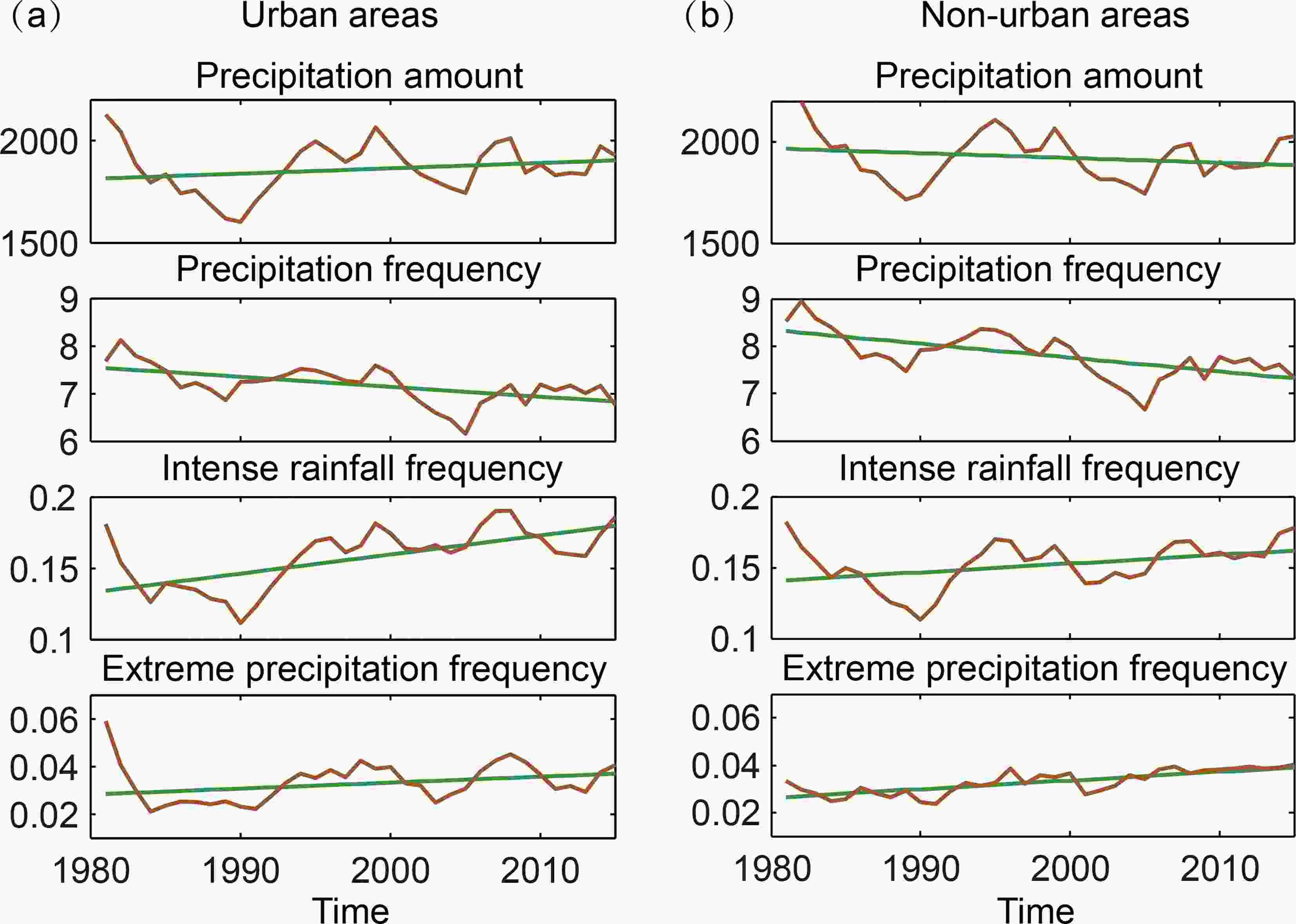 Figure2. Time series (brown) of annual precipitation (units: mm), precipitation frequency (in %) and heavy and extreme precipitation frequency (in %), and their yearly trend (green), during 1981?2015, averaged for (a) 14 stations in the PRD and (b) 9 stations surrounding the PRD.
Figure2. Time series (brown) of annual precipitation (units: mm), precipitation frequency (in %) and heavy and extreme precipitation frequency (in %), and their yearly trend (green), during 1981?2015, averaged for (a) 14 stations in the PRD and (b) 9 stations surrounding the PRD.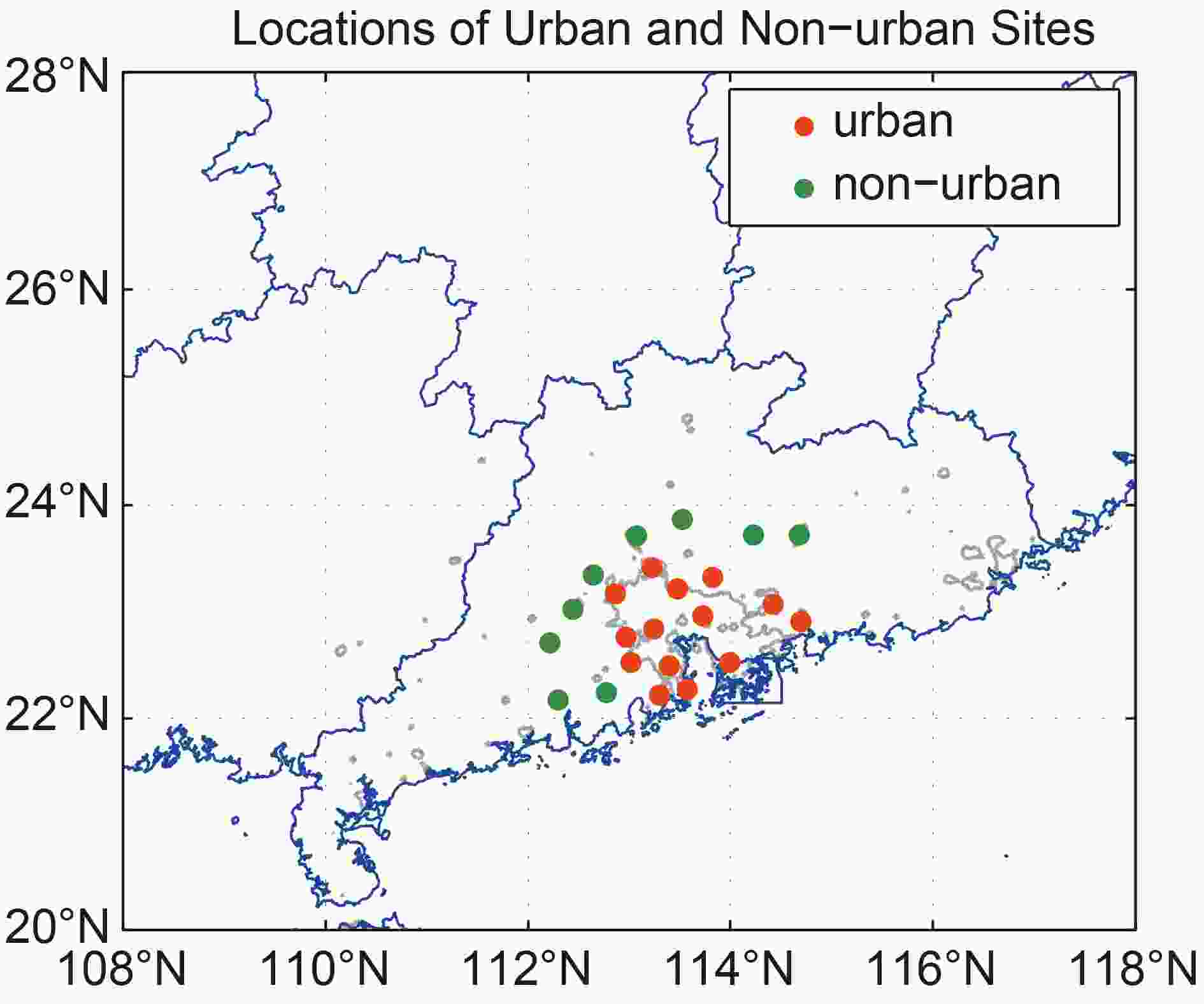 FigureA1. A map of urban and non-urban sites mentioned in Fig. 2.
FigureA1. A map of urban and non-urban sites mentioned in Fig. 2.The decrease in precipitation frequency might be partly attributable to the effect of aerosols. Rosenfeld (1999) found that a high concentration of pollutants near cities was conducive to small cloud droplet nucleation due to the increase in cloud condensation nuclei numbers, which made the cloud droplet spectrum distribution more uniform, decreased the conversion efficiency of cloud water to rain water, and thus inhibited precipitation generation. The urban heat island effect could also set up thermodynamic conditions that would enhance updrafts, elevate PBL heights, and subsequently moist convection, on the leeward or downwind side of cities, and hence more precipitation (Arnfield, 2003). Increased roughness will enhance the mechanical turbulence, which leads to a stronger low-level convergence and increased convection (Wang et al, 2014). Another modeling study, by Thielen et al. (2000), suggests that precipitation enhances with increased roughness. Thus, as a result of the accelerated urbanization, heavy rain becomes more frequent and light rain occurs less often in urban areas. Some other studies have also obtained a similar pattern: an increase in heavy and extreme rainfall events coupled with a decrease in light precipitation events over urban areas (Karl and Knight, 1998; Fujibe et al., 2005; Liao et al., 2011; Wang et al., 2014).
The increase in heavy rain and extreme precipitation for both urban and rural areas is likely a result of global warming. The warming climate could bring about an increase in atmospheric moisture, which will enhance the extreme precipitation (Trenberth et al., 2003; Westra et al., 2013). However, the fact that these increases are more significant in urban areas implies that urbanization indeed enhances the occurrence of heavy and extreme precipitation.
2
3.2. Precipitation characteristics in warm versus non-warm seasons
The period of May to October is defined as the warm season, and other months are labeled as the non-warm season. Figure 3 shows the spatial distribution of precipitation and the trend in the warm season in different periods. The precipitation amount shows an increasing trend in the urban areas (Fig. 3a). Intense rainfall frequency is increasing over larger areas, including the PRD region, north and southeast of Guangdong Province (Fig. 3b). In general, the areas where precipitation amount and intense rainfall frequency tend to increase are in good agreement, which indicates that the increase in precipitation amount mainly comes from intense rainfall during the warm seasons. The southeastern and northern parts of Guangdong Province have mountainous terrain. Topographic uplift makes precipitation and convection more likely to be triggered in these areas.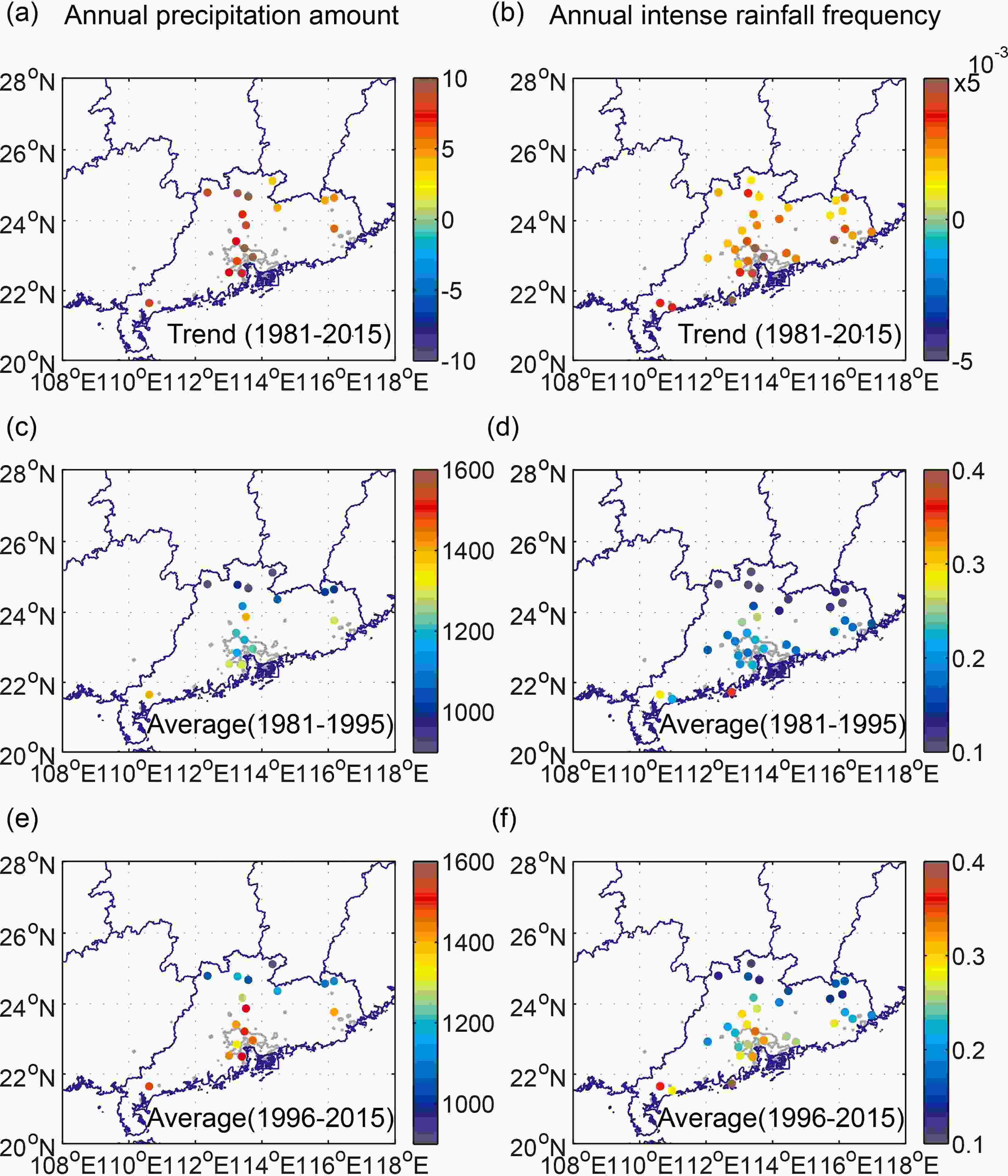 Figure3. Results for the warm seasons: trend distribution during 1981?2015 of (a) annual precipitation amount (units: mm yr?1) and (b) intense rainfall frequency (units: % yr?1); distribution during 1981?95 of (c) average annual precipitation amount (units: mm) and (d) intense rainfall frequency (units: %); distribution during 1996?2015 of (e) average annual precipitation (units: mm) and (f) intense rainfall frequency (units: %).
Figure3. Results for the warm seasons: trend distribution during 1981?2015 of (a) annual precipitation amount (units: mm yr?1) and (b) intense rainfall frequency (units: % yr?1); distribution during 1981?95 of (c) average annual precipitation amount (units: mm) and (d) intense rainfall frequency (units: %); distribution during 1996?2015 of (e) average annual precipitation (units: mm) and (f) intense rainfall frequency (units: %).During the period 1981?95, both the rainfall amount (Fig. 3c) and heavy rain frequency (Fig. 3d) are similar across many areas of Guangdong Province. However, during 1996?2015, when urbanization accelerated, the PRD region shows the higher rainfall amount (Fig. 3e) and larger trend in intense rainfall frequency (Fig. 3f). In the southern part of China, the southwest monsoon from the ocean prevails in the summer, which means the northeast of the urban areas is downwind of the city. The urban heat island effect enhances the horizontal transport of water vapor, thus strengthening the convergence and upward movement in the downwind area of the city, resulting in the increase of precipitation also in the downwind area (Inamura et al., 2011). The results indicate that urbanization intensifies the precipitation of urban and downwind areas during the warm seasons.
For the non-warm season, because of the relatively small amount of rain, the variations in precipitation characteristics barely pass the MK significance test, and are therefore not shown. There is no evidence that the precipitation characteristics of urban areas in non-warm seasons has changed significantly. Considering that little strong convection occurs during non-warm seasons, the threshold for intense rainfall was revised, to 10 mm h?1 and 5 mm h?1. The results indicate that intense rainfall frequency shows a significant decreasing trend at most stations, except for those in the PRD area. One possible explanation is that the thermodynamic conditions during non-warm seasons are generally not conducive to the triggering of strong convection. Thus, the dynamic forcing of the urban heat island-induced updrafts cannot work as effectively as during the warm seasons. However, intense rainfall still appears more in urban areas than nearby rural areas. Thus, the influence of urbanization on the precipitation during non-warm seasons still exists but is not that significant.
Influenced by the South China Sea summer monsoon (SCSSM), the region of South China, including Guangdong Province, has abundant rainfall. South China enters the main flood season after the onset of SCSSM. The flood season of South China is generally divided into two periods: the pre-flood seasons (April?June) and the post-flood seasons (July?September). Changes in precipitation characteristics during these two periods were also evaluated separately (Fig. 4). The precipitation amount (Fig. 4a) and intense rainfall (Fig. 4e) in the center of the PRD exhibit a significant increasing trend during the pre-flood seasons, while this trend is not that obvious during the post-flood seasons (Figs. 4b and f).
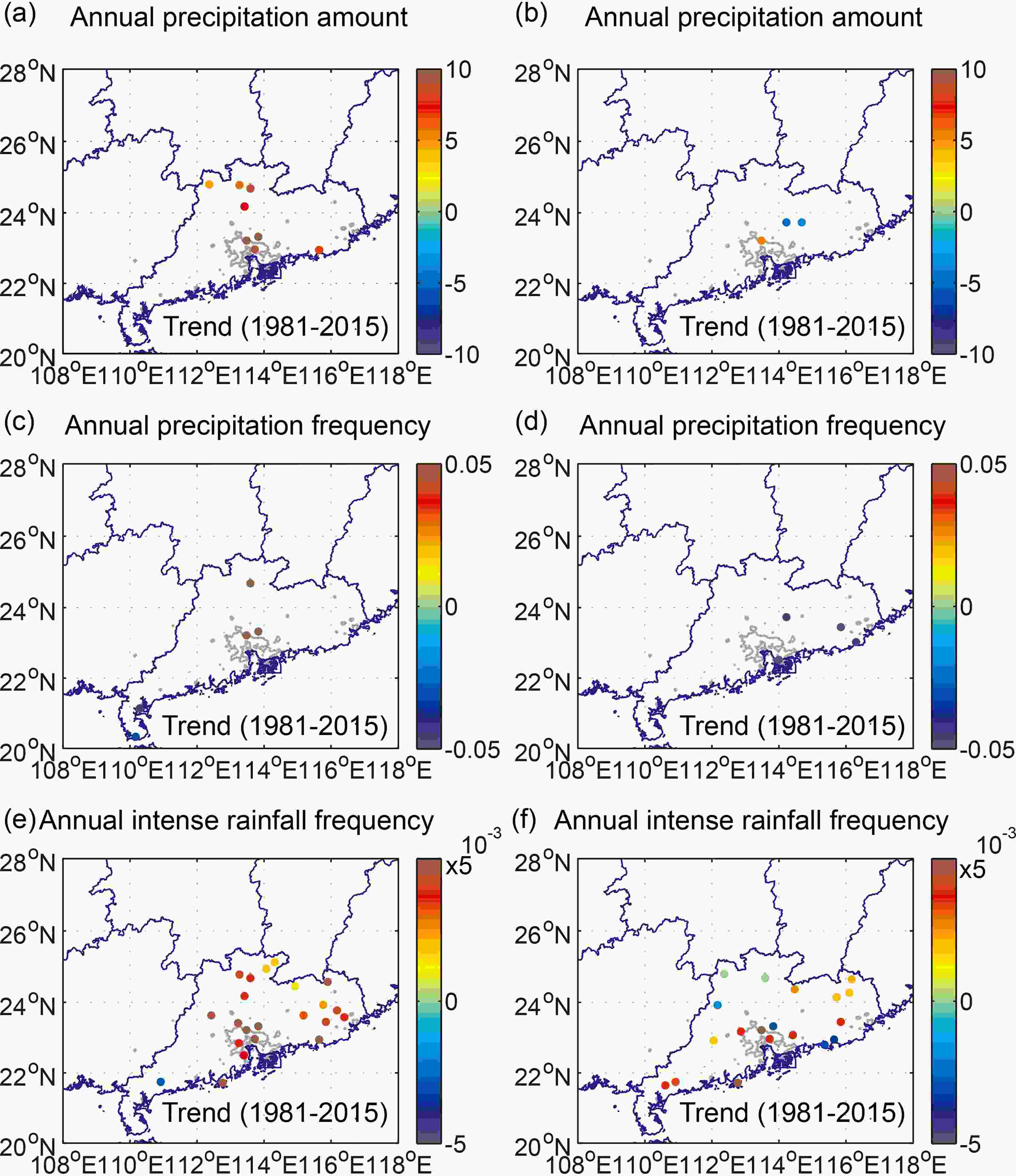 Figure4. Results for the (a, c, e) pre-flood seasons and (b, d, f) post-flood seasons: trend distribution during 1981?2015 of (a, b) annual precipitation amount (units: mm yr?1), (c, d) precipitation frequency (units: % yr?1), and (e, f) intense rainfall frequency (units: % yr?1).
Figure4. Results for the (a, c, e) pre-flood seasons and (b, d, f) post-flood seasons: trend distribution during 1981?2015 of (a, b) annual precipitation amount (units: mm yr?1), (c, d) precipitation frequency (units: % yr?1), and (e, f) intense rainfall frequency (units: % yr?1).There is a significant advance in the onset dates of the SCSSM around 1993/94: 30 May before 1994 and 14 May after 1994 (Kajikawa and Wang, 2012). The onset dates of the SCSSM have an effect on the decadal variation of monsoon rainfall in South China. The SCSSM also shows a strengthening interdecadal variability starting from 1995 (Choi et al., 2017). The advance of the SCSSM onset time and enhancement of the intensity of the SCSSM, together with the urban effects, contribute to the increase in precipitation from 1981 to 2015, especially in the pre-flood season. This also helps explain the increasing trend for other sites besides urban areas.
2
3.3. Precipitation characteristics during TC periods
TCs often make landfall along the coast of Guangdong Province and cause a lot of damage. It is useful to study the precipitation characteristics associated with landfalling TCs. In total, 106 typhoons made landfall in Guangdong Province from 1981 to 2015. The precipitation two days before to two days after typhoon landfall was considered.As expected, precipitation produced by landfalling typhoons decreases from the coast to the interior. Figure 5 shows the spatial distribution of mean precipitation and precipitation frequency during TC landfall in the period 1981?95 and 1996?2015 and their trends in the whole period. In order to eliminate the impact of changes in typhoon landing sites during these years, the numbers of typhoons that made landfall in the east and west of the PRD were counted separately. The results indicate that there is no significant change in the number of typhoons making landfall on either side during these 35 years studied (not shown).
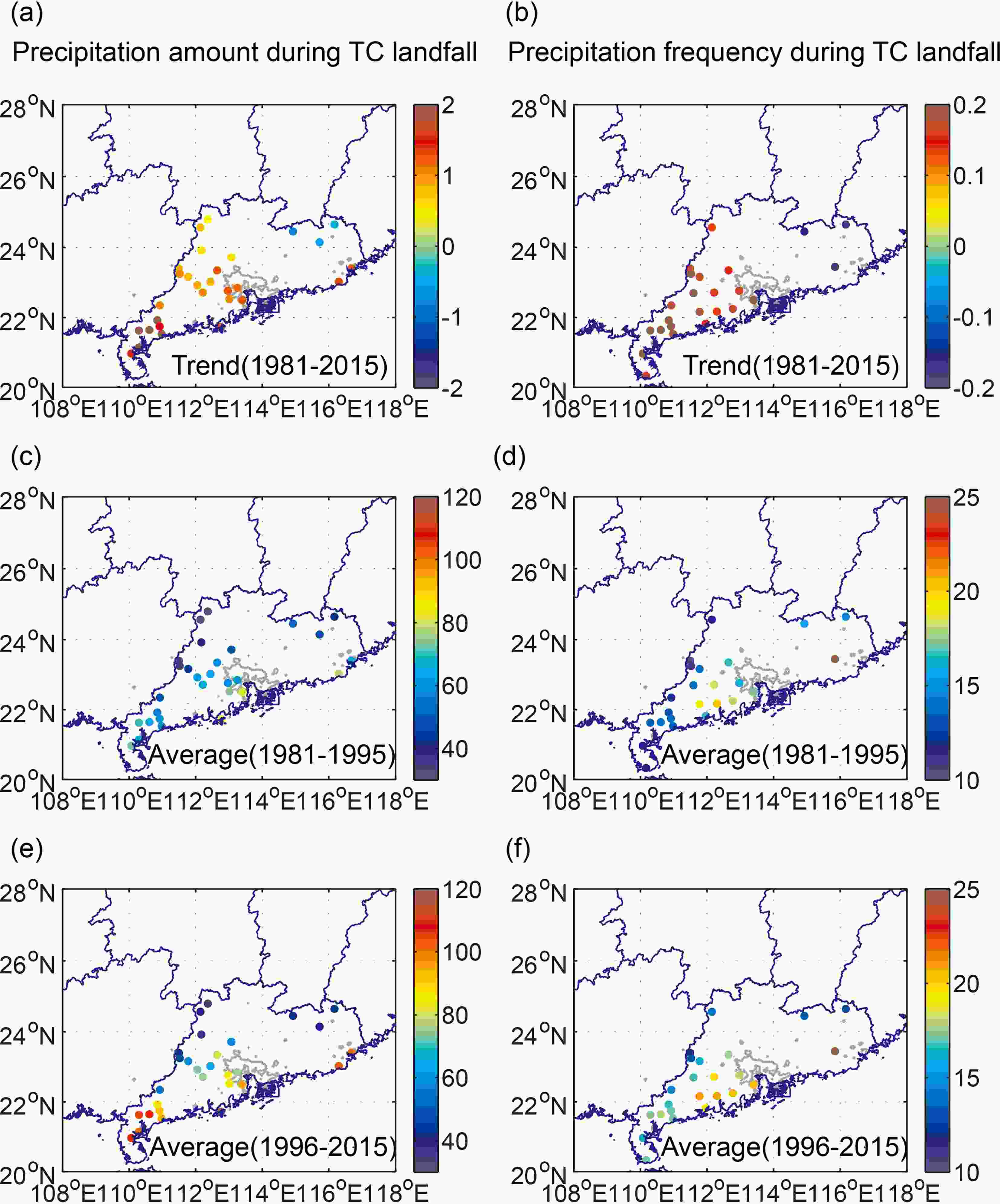 Figure5. The trend distribution of (a) precipitation (units: mm yr?1) and (b) precipitation frequency (units: % yr?1) during 1981?2015; distribution of (c) mean precipitation amount (units: mm) and (d) precipitation frequency (units: %) during 1981?95; and of (e) mean precipitation amount (units: mm) and (f) precipitation frequency (units: %) during 1996?2015. All figures are for rainfall during TC landfall.
Figure5. The trend distribution of (a) precipitation (units: mm yr?1) and (b) precipitation frequency (units: % yr?1) during 1981?2015; distribution of (c) mean precipitation amount (units: mm) and (d) precipitation frequency (units: %) during 1981?95; and of (e) mean precipitation amount (units: mm) and (f) precipitation frequency (units: %) during 1996?2015. All figures are for rainfall during TC landfall.In the urban areas and to their west, the precipitation amount and precipitation frequency both show an increasing trend during the entire period (Figs. 5a and b). During the period 1981?95, the precipitation amount is more in urban areas and the western part of Guangdong Province (Fig. 5c) The PRD and its western areas are also a high-value center of precipitation frequency (Fig. 5d). After 1995, the high-value center is more remarkable (Fig. 5f). In addition to the urban areas, precipitation also shows a significant increase over the Leizhou Peninsula (located in the western part of Guangdong Province) (Fig. 5e). The annual average intensity of typhoons making landfall along the west coast of Guangdong Province is found to have increased during these years, based on the data from the CMA (
Figure 6 shows the variation of precipitation amount (Fig. 6a) in the urban and surrounding non-urban stations (same as in Fig. 2) during TC landfall and the difference between them (Fig. 6b). The precipitation amount shows a significant increasing trend both in urban and non-urban areas. However, there has consistently been more rainfall in the urban areas than in the non-urban areas during TC landfall. In addition, the difference between the precipitation amount in urban and non-urban areas also shows an increasing trend during the 35 years included in this study. These results indicate that precipitation characteristics associated with TCs have been experiencing significant changes with the process of urbanization.
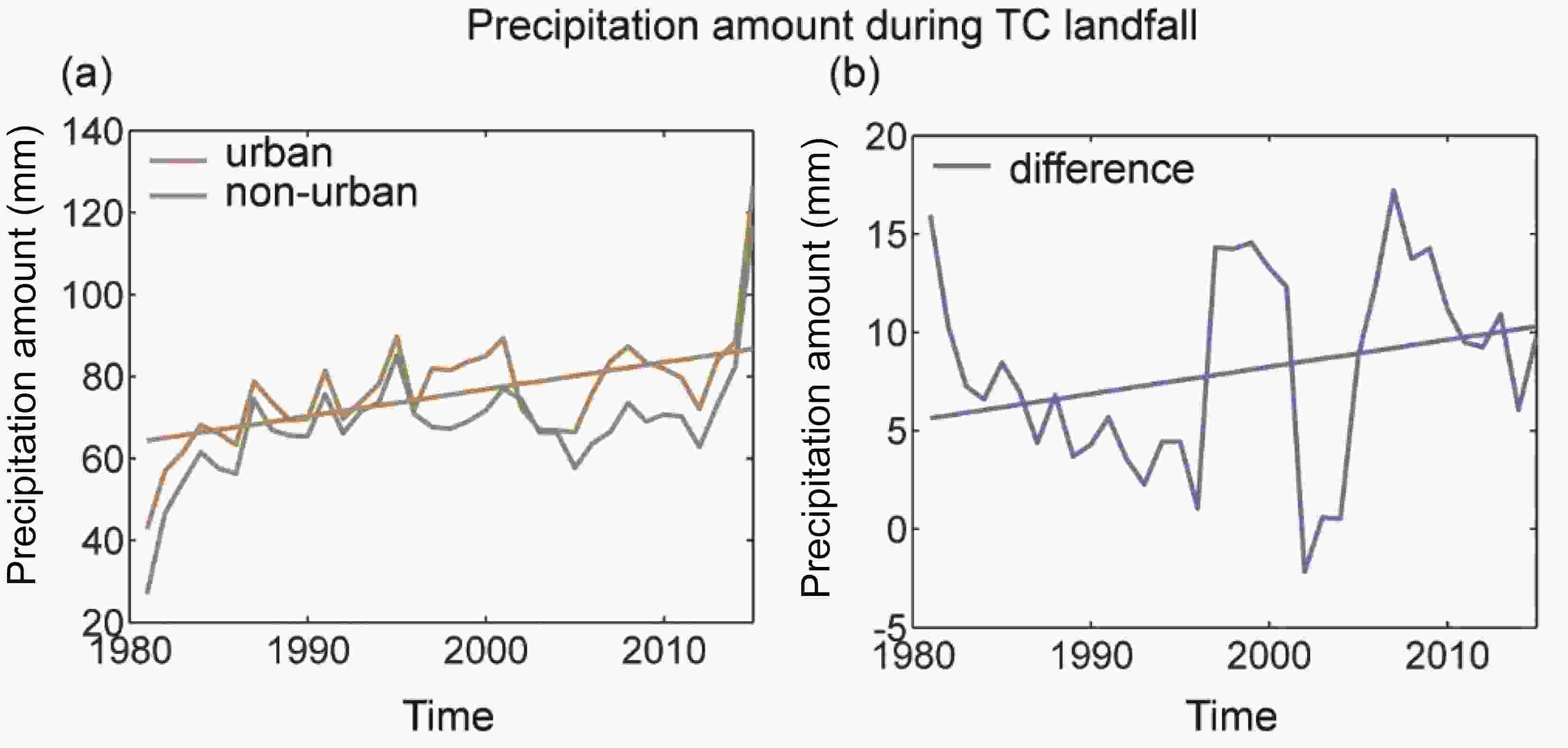 Figure6. Time series (units: mm) and trend (units: mm yr?1) of (a) annual precipitation amount in 1981?2015 during TC rainfall averaged for 14 stations in the PRD (brown) and 9 stations (green) surrounding the PRD, and those of (b) the difference between urban and non-urban stations (blue).
Figure6. Time series (units: mm) and trend (units: mm yr?1) of (a) annual precipitation amount in 1981?2015 during TC rainfall averaged for 14 stations in the PRD (brown) and 9 stations (green) surrounding the PRD, and those of (b) the difference between urban and non-urban stations (blue).The structure of convective systems can be modified when they move over cities (Bornstein and LeRoy, 1990; Tumanov et al., 1999), thus changing the precipitation distribution. The urban barrier effect could slow down the airflow of weather systems and increase its residence time over urban areas. This effect is more obvious to precipitation produced by TCs with high wind speed (Yue et al., 2019). Increases in surface roughness of the landmass have been found to lead to an enhancement of rainfall intensity associated with TCs (Chan et al., 2019). However, the actual mechanism as to how urbanization might lead to changes in the location and distribution of typhoon rain bands is still uncertain. This effect may depend on many other factors, such as topography, moisture conditions, and the dynamic structure of the storms. More studies are necessary.
The precipitation distribution in warm seasons is different from that in non-warm seasons. For warm seasons, the mean annual precipitation in 1996?2015 is remarkably greater than that in 1981?95; while for non-warm seasons, the variation of precipitation characteristics is not that significant. The increasing trend of precipitation and intense rainfall is more obvious during pre-flood seasons than post-flood seasons in Guangdong Province. In addition, the variations of precipitation characteristics during typhoon landfall over these years has also been revealed. During TC landfall, both the precipitation amount and precipitation frequency in the urban and its downwind areas are higher after 1995, and the rainfall in the PRD is consistently more than that in surrounding non-urban areas, indicating that precipitation produced by typhoons has been enhanced with the accelerated process of urbanization.
The urban heat island circulation and the reduction in wind speed of the urban underlying surface may enhance convective precipitation. The effect of aerosols is beneficial to the nucleation of small cloud droplets and thus inhibits the precipitation frequency. The combined effects of urbanization can therefore lead to these observed changes in precipitation characteristics. In addition, some interannual variations of rainfall are related to the local circulations, such as land?sea breezes. The increase of intense rainfall is mostly observed at the coastal or windward sites where the onshore monsoon flow induces convergence. Coastal morning rainfall is enhanced by the coastal convergence and mountain liftings of monsoon shear flow interacting with land breezes (Chen et al., 2017, 2018).
As shown in other studies, urbanization changes the spatial distribution, amount, frequency and intensity of precipitation over and downwind of cities (Han et al., 2014). Urbanization modifies the exchanges of momentum, heat and moisture between the land surface and the atmosphere (Crutzen, 2004). The atmospheric composition over the urban areas is also changed (Pataki et al., 2003). More research is required to identify the main reasons for the changes in precipitation characteristics in urban areas and the exact mechanisms involved. For future work, sensitivity experiments will be run from the perspective of urban anthropogenic heat and land properties, including surface friction, topography, and local and remote moisture availability, to investigate how urbanization will influence the rainfall in urban and surrounding areas.
Acknowledgements. This work of Kun ZHAO was primarily supported by the National Key Research and Development Program of China (Grant Nos. 2017YFC1501703 and 2018YFC1506404), the National Natural Science Foundation of China (Grant Nos. 41875053, 41805025, 41475015 and 41322032), the Open Research Program of the State Key Laboratory of Severe Weather, and the 5th “333 High-level Personnel Training Project” of Jiangsu Province (BRA2019037). The work of Meng YAN and Johnny C. L. CHAN was supported by the Research Grants Council of the Hong Kong Special Administrative Region of China (Grant No. CityU 11301417). We acknowledge the CMA for collecting and archiving the rain gauge data. Surface data were provided by the National Meteorological Information Center of the CMA (
APPENDIX
